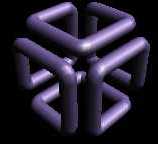


 |

|

|
Home | | Syllabus | |
Assignments | |
Documentation
Solution to Assignment 1
Problem 1: Objects in the distance have smaller images than those that are close when projected onto an image plane with perspective projection. The projection of images through the lens of the eye can be modelled (approximately) as perspective projection, and so objects that are farther away will have smaller images. To see this mathematically, recall the equations for the projected image point (x,y) from a point P in the world (X, Y, Z) are given by:
y = Yd/Z
This idea of image size varying with distance is not intuitively obvious when you think about your own visual field. This is because your brain automatically compensates for the smaller images, so that things in the distance look (for the most part) their right size. This is known as "Size constancy" in the psychology literature. This is probably one of the reasons it took so long for painters to work out the theories underlying the use of perspective in drawing and painting. Problem 2: a) Given the equations for perspective projection, with d = 1, the four points project as follows:
P1: (0.5, 0.5, 1.0); x1 = .5/1, y1 = .5/1; p1 = (0.5, 0.5); P2: (1.0, 0.0, 1.0); p2 = (1.0, 0.0); P3: (0.0, 0.0, 1.0); p3 = (0.0, 0.0); P4: (1.0, 1.0, 2.0); p4 = (0.5, 0.5);
b) Now, the observer takes a step back, so Z increases by 1. We now have the following projections: P1: (0.5, 0.5, 2.0); x1 = .5/2, y1 = .5/2; p1 = (0.25, 0.25); P2: (1.0, 0.0, 2.0); p2 = (0.5, 0.0); P3: (0.0, 0.0, 2.0); p3 = (0.0, 0.0); P4: (1.0, 1.0, 3.0); p4 = (0.33, 0.33);
c) The image in part a looks like a triangle, and one might assume it arose from a simple, connected triangle in space. The image in part b is no longer a simple triangle, since one of the edges extends out past the top vertex. If one saw these two images side by side, one would probably assume they arose from different objects. This illustrates how one's (or the camera's) viewpoint can have a large affect on one's interpretation of the image. If simply moving one step back can cause such a change in the image, imagine what could happen if you rotated the camera!
Problem 3: Spirals Here is one solution: C code for solution to spiral problem
Home | | Syllabus | | Assignments | | Documentation
Constance Royden--croyden@mathcs.holycross.edu
|